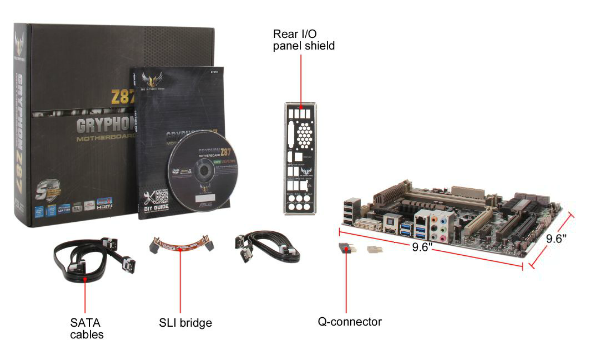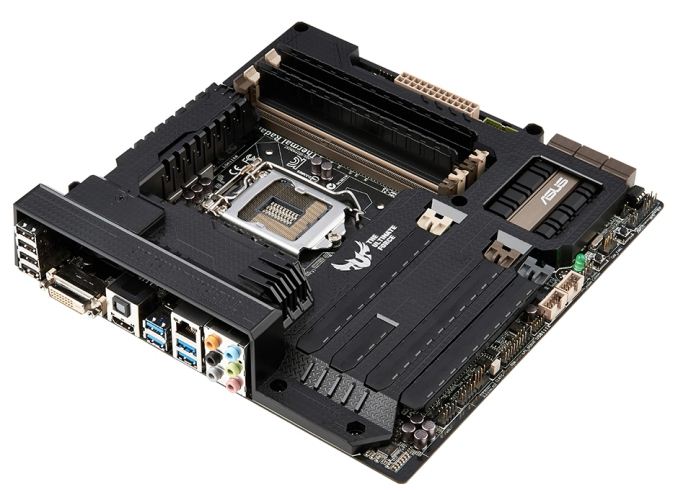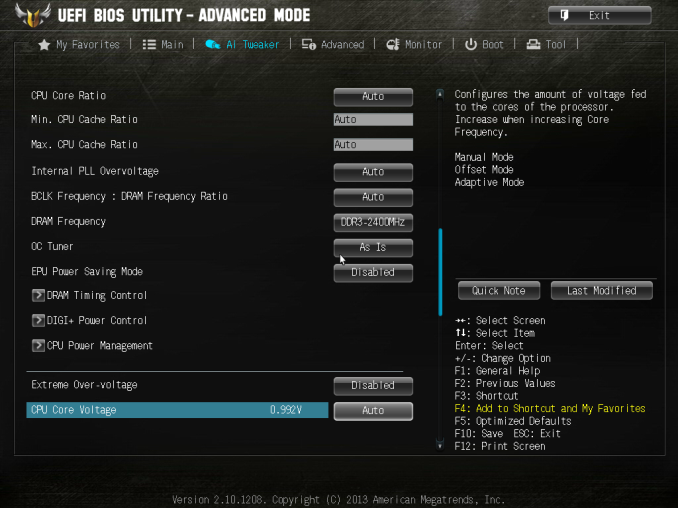ASUS TUF Z87 Gryphon Review
by Ian Cutress on February 3, 2014 10:00 AM EST- Posted in
- Motherboards
- Asus
- Z87
- TUF
ASUS TUF Z87 Gryphon In The Box
Looking back on the original outset of the review, I guess I had no inclination as to what exactly the box of a TUF motherboard would have in it. Given the market for the TUF is towards the longevity and stability of a product, one could argue that safety could be tacked on as well and some form of modified screws with a special screwdriver could be added. Given that the Z87 Gryphon is a ~$162 motherboard, the box contains the following:
Driver DVD
Rear IO Shield
Manuals
Four SATA Cables
Flexi-SLI Bridge
Q-Connectors
Ultimately this is almost the bare minimum ASUS could have put in the box – remove a couple of SATA cables and the SLI bridge would be the minimum compared to what we have seen with lower price segmentation. There is scope here for ASUS to have included something to represent the TUF brand, such as a sticker for a case or a poster. Though I guess what ASUS want users to buy is the Armor Kit, available separately:
ASUS TUF Z87 Gryphon Overclocking
Experience with ASUS TUF Z87 Gryphon
As one might imagine, a motherboard built for stability might not necessarily pull out all the stops to become the best overclocking motherboard on the market. This is probably seen best by the Gryphon’s lack of automatic overclock options – we only found two, and these were further down the overclocking page in the BIOS.
That being said, if ASUS was attempting to escape overclocking, they would have used the H87 chipset. Using some intuition and the manual overclock settings, our CPU still managed to hit the 4.6-4.7 GHz range similar to previous Z87 motherboards we have tested. Motherboards built for longevity and overclocking motherboards are often cut from similar bits of cloth, although the testing applied to either will be different.
Methodology:
Our standard overclocking methodology is as follows. We select the automatic overclock options and test for stability with PovRay and OCCT to simulate high-end workloads. These stability tests aim to catch any immediate causes for memory or CPU errors.
For manual overclocks, based on the information gathered from previous testing, starts off at a nominal voltage and CPU multiplier, and the multiplier is increased until the stability tests are failed. The CPU voltage is increased gradually until the stability tests are passed, and the process repeated until the motherboard reduces the multiplier automatically (due to safety protocol) or the CPU temperature reaches a stupidly high level (100ºC+). Our test bed is not in a case, which should push overclocks higher with fresher (cooler) air.
Automatic Overclock:
The automatic overclock settings are found in the OC Tuner option of AI Tweaker in the BIOS. Selecting this gives two further options to select: Ratio First and BCLK First.
Selecting Ratio First gives a CPU multiplier of 43x/42x/42x/41x, meaning 4.3 GHz in single thread mode down to 4.1 GHz at full load. Over the base CPU turbo, this means an extra 300 MHz on the single thread setting. The BIOS still showed ‘Auto’ for CPU voltages and Load Line Calibrations, and in the OS this gave a load reading of 1.136 volts. PovRay scored 1696.45, and OCCT gave a maximum temperature of 71C. XMP was applied automatically also.
On the BCLK First option, the CPU was adjusted to the 125 MHz strap, giving a 34x125 scenario for all threads, or 4.25 GHz all over. Again the BIOS reported an automatic setting for voltages, although in the OS this meant 1.174 volts during OCCT with a peak temperature of 75C. PovRay scored 1757.7.
Manual Overclock:
For our manual overclock we stayed in the BIOS and started from 4.0 GHz and 1.000 volts. When the system was stable (PovRay + 5 mins OCCT) the multiplier was raised, and for any failure the voltage was raised by +0.025 volts using a fixed voltage application. The following results were achieved:
At 4.7 GHz the system was stable but failing our OCCT temperature tests, giving over 90C. Despite using a TRUE Copper heatsink for this test, better cooling would be needed to push the CPU further.














62 Comments
View All Comments
Samus - Tuesday, February 4, 2014 - link
5thaccount, did it ever occur to you the reason you saw so many Asus returns is because they are the largest motherboard manufacturer in the world, and chances are if a noobie builder is buying a board, it's going to be...Asus?Eagle007 - Tuesday, February 11, 2014 - link
I am currently in litigation with ASus over a $350 motherboard they said was defective but have not returned to me. They have spent at least $5000 not to fight the suit and not return the board. They tortured me with emails, unanswered, and chat instructions for days before issuing a RMA. Do not buy a product from them with a five year warranty as it guarantees that you will be abused by them for 5 years rather than protected from failures.Hxx - Monday, February 3, 2014 - link
lol thats so dumb is ridicoulos. Asus makes excellent board, they have always done at least in the past 10 years since ive been building my own rig. Always use them Id rather get a lower specced Asus board than a higher specced msi or gigabyte. This is not just me speaking from experience, you can read forums upon forums of people expressing similar opinions. You're either trolling or got extremely unlucky. I just sold an x38 asus p5e board for over 100 bucks on ebay if that says anything.probedb - Tuesday, February 4, 2014 - link
Odd. I've had nothing but Asus motherboards since the days of Ahtlon XP processors and none have ever missed a beat.twtech - Friday, February 7, 2014 - link
I had a bad experience with an ASUS motherboard a few builds ago - which was actually something like 6 years now. The board was overvolting the RAM, so initially it would appear stable, and then degrade after a few months and start locking up with increasing frequency. I replaced the power supply, and the RAM twice before I figured out what was actually going on.Searching for information about the issue revealed that it was actually a relatively common problem, and that the voltages displayed in the BIOS couldn't be trusted. A workaround was to manually set the RAM voltage lower, to a number that appeared to be out-of-spec. I wasn't sure how much of an offset needed to be set though, and eventually the board destroyed that set of RAM sticks too. At that point I got rid of the board.
Since then, I have been wary about purchasing another ASUS motherboard. It was probably just that model that was problematic, but having other options, it's still hard to choose to go back to a manufacturer that shipped boards with an issue as significant as that. Especially when they typically want a premium for their boards, too.
Neo123 - Sunday, February 16, 2014 - link
hi i planned to buy PC..which brand motherboard is best..in service and relablityFractinJex - Monday, February 3, 2014 - link
Both obv. not to bright....I stated until I upgrade in 4-5 years did I state the board would only last that long....noAlso this board as a 5 year warranty unlike 90% of other boards that have 3 year warranty. This is currently one of the best mATX boards available...
djshortsleeve - Wednesday, February 5, 2014 - link
No kidding, I think I have used 10-15 year old MOBOs. Rarely do they ever die.drainplugofideas - Monday, February 3, 2014 - link
Oh cool! I made nearly the same build. Cooler master n2000, i5-4670k, gtx 770, corsair MX 650.Sabresiberian - Monday, February 3, 2014 - link
I have one, too, quite happy with it. My only "complaint" is that the armor kit comes separately for a rather expensive price too, so that made what I paid pretty high all total. Still there are other premium small form factor mainboards in that price range (board+armor kit) - and with a 3 year warranty in stead of 5.The lower priced sound solution is a plus for me because I don't use mainboard sound, so the less it adds to the cost of the board the better for me. :)